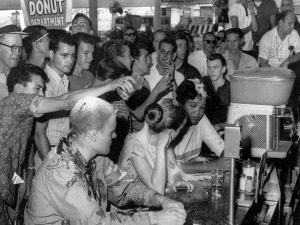
William Yeingst, chairman of the National Museum of American History and Life in Washington D.C., refers to the protest against segregation at the Greensboro facilities as a “significant part of a larger collection [of artifacts] about participation in our political system.” The Civil Rights Movement was a struggle for social justice for African Americans that primarily took place in the 1950s and 1960s in the United States.
Several protests occured during this time, mainly concerning the separation of blacks and whites in public and private facilities. The Greensboro lunch counter sit-in was an example of how the desegregation movement began. David Richmond, Ezell Blair Jr., Franklin McCain, and Joseph McNeil, four African American freshmen at the Agricultural and Technical College of North Carolina, started this powerful, significant movement of the Civil Rights Era.
African Americans in the South experienced more racial injustice than in the North; Jim Crow laws were much stricter. “I was still the same person, but I was treated differently,” stated McNeil, describing the atmospheric shift from north to south. While it was essential to get all of the U.S. integrated, the primary focus targeted the southern states.
The Greensboro Four strategically worked to peacefully desegregate the lunch counters at Woolworth’s Five and Dime in Greensboro, North Carolina by initiating a staged sit-in. Ralph Johns, a local white businessman, helped construct their plan of action. The four were influenced by Mohandas Gandhi who was widely known for his remarkable non-violent protests. The Freedom Riders, a group of activists who worked to integrate the Greyhound and Trailways buses, also influenced the men.
On February 1, 1960, the four sat down at the counters but were ignored by the waitresses because Woolworth’s policy was to serve only white people and staff members. However, the men refused to give up their seats. Police were called but could not enforce action because the men did not rebel or fight back. Ralph Johns alerted the media so everyone could see the event on television. The four did not leave until the store closed, lasting nearly all day.
A couple of days after the incident, approximately 60 students and three waitresses occupied the lunch counter seats in support of the protest. The following day, about 300 students joined the protest against segregation. Responding to the full coverage on national television, many students across the country were motivated to protest with the Greensboro Four. Fifty-five cities in 13 states had activists peacefully protesting in libraries, hotels, and restaurants. Protesters faced consequences such as getting arrested for trespassing, disorderly conduct, and disturbing the peace.
These protests lasted for nearly six months. On July 25, 1960, dining areas across the South were integrated. The sit-ins were one of many ways blacks in America reshaped the foundation of justice in the U.S. “The sit-in at the Greensboro Woolworth’s was one of the early and pivotal events that inaugurated the student-led phase of the Civil Rights Movement,” stated William Yeingst.
[Source:
Smithsonian.com, History.com, BlackPast.org
]

